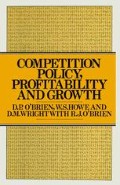Abstract
In this chapter we are concerned with total growth. This includes, therefore, both internal growth and external growth through acquisition and merger. We will deal with the question of external growth separately in Chapter 6. At present our concern is with the total progress of the enterprise. It did not seem desirable to subtract external from total growth to obtain internal growth because the two are, to some extent, substitutes. (In any case our external growth data may be incomplete.) It seemed more appropriate to look at the total experience of the enterprise and then to look at its external growth. Nevertheless, because total growth includes acquisitions, the data tend to exhibit extreme values.1 But these occur mainly in the third of our periods, and the problem is not so acute in the first and second periods. However, as the notes to Tables 4.1 and 4.2 indicate, we did find it necessary to omit some extreme values to run the parametric tests at all.
Access this chapter
Tax calculation will be finalised at checkout
Purchases are for personal use only
Preview
Unable to display preview. Download preview PDF.
Author information
Authors and Affiliations
Copyright information
© 1979 D. P. O’Brien, W. S. Howe and D. M. Wright with R. J. O’Brien
About this chapter
Cite this chapter
O’Brien, D.P., Howe, W.S., Wright, D.M., O’Brien, R.J. (1979). Assets. In: Competition Policy, Profitability and Growth. Palgrave Macmillan, London. https://doi.org/10.1007/978-1-349-04483-2_4
Download citation
DOI: https://doi.org/10.1007/978-1-349-04483-2_4
Publisher Name: Palgrave Macmillan, London
Print ISBN: 978-1-349-04485-6
Online ISBN: 978-1-349-04483-2
eBook Packages: Palgrave Economics & Finance CollectionEconomics and Finance (R0)

